The wiki is lacking in content. You can help by creating a new article. See the to do list for more ways you can help.
Account creation has been restricted to people who have accounts. Please stop by the Discord Server to request an account.
Final Fantasy IV
| This article is about 2D versions of Final Fantasy IV. For the 3D remake that was first released on Nintendo DS, see Final Fantasy IV (3D remake). |
| Final Fantasy IV | |
|---|---|

| |
|
ファイナルファンタジーIV | |
| Developer(s): | |
| Publisher(s): |
Square |
| Platform(s): |
Super Nintendo Entertainment System, PlayStation, WonderSwan Color, i-mode, EZweb, Yahoo! |
| Release date: |
Super Nintendo: |
| Genre: |
Role-playing game |
| Modes: |
Single player |
| Ratings: |
CERO: A |
| This article uses content from Wikipedia (view authors), and falls under the compatible Creative Commons license. |
Final Fantasy IV is the fourth installment of the Final Fantasy series. It was originally released for the Super Nintendo Entertainment System in July 1991 for Japan and November 1991 in North America. It was the second Final Fantasy game to release in North America, so the original release was titled Final Fantasy II. In October 1991, a month before the North American release, an easier version of Final Fantasy IV released in Japan, titled Final Fantasy IV Easy Type.
Final Fantasy IV is the first game with Active Time Battles, where characters and opponents fight in real time, meaning that they do not wait for the other side to attack. This feature has been included in subsequent Final Fantasy games and other RPGs in general. Final Fantasy IV is one of the earliest games to utilize the Mode 7 graphics chip. The game received critical acclaim upon its release.
Like other 2D Final Fantasy titles, Final Fantasy IV received several reissues over the years, and several of the lesser significant releases were exclusively released in Japan. In 1997, the game received a PlayStation remake in Japan. In 2001, Final Fantasy IV was included on the North America-exclusive compilation title, Final Fantasy Chronicles and has since dropped its Final Fantasy II title. In 2002, another remake was released for WonderSwan Color. In 2005, Final Fantasy IV was released for the Game Boy Advance under the title Final Fantasy IV Advance. In 2008, the game received a 20th Anniversary Edition remake for the Nintendo DS, following after the 3D remake of Final Fantasy III.
In 2009, the game received a follow-up title, Final Fantasy IV: The After Years, which was first released as a WiiWare title. In 2011, both Final Fantasy IV and its follow-up were included on the compilation title, Final Fantasy IV: The Complete Collection.
Story[edit]
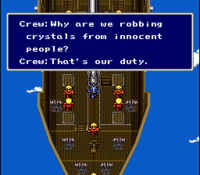
Final Fantasy IV begins with the monarchy of Baron using the Red Wings to attack peaceful nations and find four powerful Crystals that correspond to the classical elements. Cecil questions the king's motives after stealing the Water Crystal from the town Mysidia, where several of its inhabitants were killed. Upon questioning the king, Cecil is stripped of his rank and is sent with Kain to deliver a package containing the Carnelian Signet to the village of Mist. To reach the mountain valley where the Village is located, the two traverse the Mist Cave and defeat the Mist Dragon guarding it.
Upon reaching Mist, Cecil and Kain discover that the package is an explosive. It explodes and causes destruction of the town and kills many of its inhabitants. In the ensuing chaos, Cecil and Kain encounter Rydia, a young female survivor standing over her mother's body. Rydia's mother was spiritually connected to the Mist Dragon; the dragon's death ended her life as well. The infuriated girl summons a monster to attack Cecil and Kain; it causes an earthquake, which cuts off the route back to Baron and knocks the three unconscious. When Cecil awakens, he discovers that Kain has disappeared and the girl is injured. He carries her to an inn at Kaipo.
Soldiers from Baron arrive in the night to abduct the girl on orders from the king of Baron to kill all Summoners, and Cecil defeats them; impressed, Rydia joins him. While in Kaipo, Cecil discovers a bedridden Rosa. While searching for Cecil, she contracted an ailment curable only by the Sand Pearl, released when the Antlion lays its eggs. Access to the Antlion's lair is controlled by the Kingdom of Damcyan, so Cecil and Rydia travel north to Damcyan through the desert and an Underground Waterway through the mountains. There, they meet a sage named Tellah, who is also traveling to Damcyan in search of his daughter Anna. The three arrive just in time to witness the Red Wings attacking the kingdom. In investigating the ruins of the castle, they discover that Anna was killed in the assault; Tellah blames her death on her lover, Edward Chris von Muir, the smitten bard. Edward explains that a warrior named Golbez orchestrated the attack to steal Damcyan's Fire Crystal, prompting Tellah to leave the party to seek vengeance on Golbez for her death. Edward joins Cecil and Rydia and helps them retrieve the Sand Pearl.
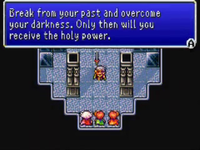
At Kaipo, the revived Rosa joins the party, which resolves to go to Fabul to protect the Wind Crystal from being stolen by Golbez and the Red Wings. Along the way, while crossing Mt. Hobs, they encounter Yang, the head of the Fabul Monks, being ambushed by Golbez's monsters; the party helps him fight them off. Yang requests Cecil's help in defending Fabul after they inform him of Golbez's plot. At Fabul, the Red Wings attack and Cecil's party slowly retreats through the halls of the castle to the room containing the Wind Crystal, where he is confronted by his friend Kain and learns he is affiliated with the Red Wings. Kain challenges and defeats him in a duel. Golbez arrives, kidnaps Rosa, and steals the Wind Crystal. The next morning, Cecil and Yang decide to sneak into Baron to acquire an airship from Cid for a rescue attempt. After considering Baron's weak sea defenses, Yang charters a ship to take Cecil, Edward, Rydia, and himself to Baron. While sailing, they are attacked by the sea monster Leviathan and the party is scattered.
Cecil awakens on a beach near Mysidia, where he is met with contempt by the town's wizards for stealing the Water Crystal earlier. However, the Mysidian elder understands Cecil's plight, and tells him that to defeat Golbez, Cecil must climb Mt. Ordeals, surrender his dark sword and become a Paladin. The elder sends twin wizards Palom and Porom to assist and spy on Cecil. On the mountain, they encounter Tellah, who is searching for the legendary spell Meteor to defeat Golbez. Golbez attempts to stop the party by sending Scarmiglione, the Fiend of Earth, to stop them, but the party defeats the demon, Cecil completes the trials, and becomes a Paladin; in the process, Tellah also learns the secret of Meteor.
Upon returning to Mysidia, the town elder is impressed that Cecil successfully became a Paladin and allows him the use of the Serpent Path, a teleporter that takes the party to Baron. There, Cecil learns that Cid has been arrested and Yang brainwashed into the service of Baron. After helping Yang recover, Cecil, Yang, and the others infiltrate the castle and discover that the king is actually the Fiend of Water, Cagnazzo. After defeating him, Cid is freed and takes Cecil and his friends to his newest airship. Before dying, Cagnazzo causes the walls of the castle to move with the intent of crushing the party. Palom and Porom petrify themselves to halt the trap.
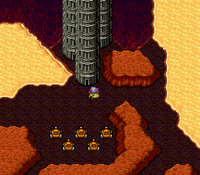
Cecil takes command of the airship and is met at takeoff by the brainwashed Kain, who demands Cecil retrieve the final Crystal in exchange for Rosa's life. Cecil heads for Troia, where the Earth Crystal is enshrined. He learns the Crystal was stolen by the Dark Elf, and his friends and he retrieve it. Kain leads the group to the Tower of Zot, where Rosa is imprisoned. After the party battles to the tower's summit, Golbez takes the Crystal and tries to flee. Tellah uses Meteor to try and kill Golbez, only to be killed instead, although Golbez is weakened, therefore shattering his control over Kain's mind. Kain helps Cecil rescue Rosa and, after defeating the Fiend of Wind, Barbariccia, the party escapes to Baron.
In Baron, Kain reveals that Golbez must also obtain four subterranean Dark Crystals to achieve his goal. Cecil swears to defend the Crystals; Kain gives him a Magma Rock he obtained while in the service of Golbez that is instrumental to accessing the Underworld. The party is initially unsure of how to use it, but they eventually discover the town of Agart, whose inhabitants claim descent from the dwarves of the Underworld. Thinking this town may have the secret to accessing the Underworld, Cecil drops the Magma Rock into the town's deep well, triggering an earthquake that opens a passage to the Underworld. They fly through the opening, but their airship is soon damaged while caught in the cross-fire of a battle between the dwarves' tanks and the airships of the Red Wings, forcing it to crash outside the Castle of Dwarves. King Giott of the dwarves accepts Cecil's offer to guard the Crystals. Cid departs to repair and upgrade the airship; soon after he leaves, Cecil, Rosa, Yang, and Kain discover Golbez has infiltrated the dwarves' crystal room and try to stop him from stealing the Crystal. During the battle they are joined by Rydia, who was sucked into the Underworld by Leviathan. However, Golbez escapes with the Dwarves' Dark Crystal, and Cecil sets out to the Tower of Babil to retrieve the lost crystals. King Giott offers the services of his tanks to draw the fire of the tower's defenses while the party infiltrates it. While inside, the party confronts Golbez's servant Dr. Lugae. After defeating him they are informed the crystals have been moved to that portion of the Tower that is above ground. As his last act, Dr. Lugae orders that the Tower's Super Cannon destroy the dwarf tanks. Yang volunteers to stay behind and destroy the Super Cannon while the party escapes, and is presumed dead.
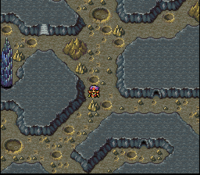
Upon escaping the Tower, the party is met by Cid and a repaired airship. They are pursued by the Red Wings and fly back to the upper world to escape them; Cid throws himself overboard and detonates a bomb to re-seal the passage, apparently sacrificing himself. Back on the surface, they find the path to the Tower of Babil's upper half. While following it they encounter Edge, the ninja prince of Eblan, who seeks revenge on Rubicante for the death of his parents; Edge joins the party. Inside the tower, the party defeats Rubicante but falls through a trap door to an Underground portion of the Tower and finds an abandoned Red Wing airship. After returning in it to the Castle of Dwarves and consulting with King Giott, Cecil and the others decide to go to the Underground's Sealed Cave and retrieve the eighth and final crystal before Golbez gets to it. After they succeed in doing so, however, Golbez takes back control over Kain and forces him to steal the Crystal. Back at the Dwarf Castle, Giott tells Cecil of the Lunar Whale, a ship designed to take travelers to and from the moon. Cid, who was found by the dwarves and nursed by them back to health, fits their airship with a drill and the party drills their way back to the surface. Cecil returns to Mysidia to pray for the Lunar Whale's appearance. It rises from the ocean, and Cecil, Rosa, Rydia, and Edge board it to travel to the moon.
Upon arriving on the moon, the party enters the only visible structure, the Lunar Palace, and there the party meets an elderly man named Fusoya who explains that Cecil's father is a heroic but deceased Lunarian. Fusoya also explains that a Lunarian named Zemus plans to destroy life on the Blue Planet to facilitate Lunarian inhabitation. To achieve this, Zemus manipulated Golbez and Kain to obtain the Crystals needed to revive a giant destructive android, the Giant of Babil. Meanwhile on Earth, the forces of the world, including some characters (Yang, Palom, Porom) thought to have died, hopelessly attack the unleashed Giant. Fusoya, Cecil, Rosa, Rydia, and Edge enter and destroy the Giant. Fusoya breaks Zemus' control over Golbez and Kain, and Cecil learns that Golbez is his brother. After destroying the Giant, Golbez and Fusoya head to the core of the moon to defeat Zemus. Cecil's party follows after reuniting with Kain. After battling to the moon's core, the party witnesses Golbez and Fusoya defeat Zemus but quickly lose to his ultimate form, Zeromus. With the united life force of all beings combined with a special Crystal provided by Golbez, Cecil and his party defeat Zeromus. Following the conflict, Golbez decides to remain dormant along with the other Lunarians, as he would not be welcome on Earth. One year later, the heroes reunite for Cecil and Rosa's wedding and coronation as Baron's king and queen.
Gameplay[edit]
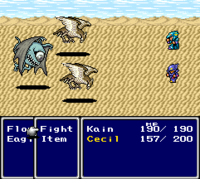
As with other Final Fantasy games, Final Fantasy IV features exploration on the world map. The player can have up to five party members. As the party progresses, they receive more options to travel the world map, such as by airship or by riding a Chocobo. The world map shows assorted towns and dungeons, each represented by an icon. The party can access a location on the world map by moving to it. Several dungeons take place either inside or outside of a mountain and usually end with a boss battle. Final Fantasy IV is more linear compared to other RPG titles, and has only a few side-quests.
Like other Final Fantasy games, when a located is accessed from the overworld, the screen zooms in closer. Towns and villages each have an inn, where the characters can pay a fee to rest at and restore all of their HP and MP. Towns and villages also have shops, and later ones sell more effective items and stronger weapons to reflect the game's increasing difficulty. In towns and villages, there are houses that can be entered, and the party can talk to the person inside of the house. The villages have various objects where small items are hidden, such as a potion or some gil. Certain areas have a Fat Chocobo, which can store some items for the party.
Battles are not much different than in earlier Final Fantasy installments. As characters gain experience points, they level up, which increases their stats. There are four types of magic: White Magic, which is used for healing and support magic; Black Magic, which is used for offensive magic; Summon, a type of magic only usable by Rydia in which she calls forth a creature to attack an enemy; and Ninjitsu, a specialized type of attack magic used by Edge. Characters who can cast spells learn them as they level up.
Final Fantasy IV is the first game to feature the Active Time Battle system, in which the characters fight in real time. However, there is no gauge that indicates the order and time when party members can attack, as this feature would later be introduced in the following title, Final Fantasy V.
Release history[edit]
Final Fantasy IV Easy Type[edit]
The game's first re-release is Final Fantasy IV Easy Type, released exclusively in Japan for the Super Famicom in October 1991, a few months after the game's original release. This version has various changes to make it easier, such as enhancing the attack power of weapons and the protective abilities of certain spells and armor. The North American Final Fantasy II release is partially based on Final Fantasy IV Easy Type.
North American localization[edit]
Because the previous two installments of the Final Fantasy series had not been localized and released in North America at the time, the original Super Nintendo release of Final Fantasy IV was distributed as Final Fantasy II to maintain naming continuity. This remained the norm until the release of Final Fantasy VII in North America (after the original Super Nintendo release of Final Fantasy VI under the title of Final Fantasy III) and subsequent releases of the actual second and third installments, Final Fantasy II and Final Fantasy III respectively, on various platforms.
The English localization of Final Fantasy IV retains the storyline, graphics, and sound of the original, but the developers significantly reduced the difficulty for beginning gamers. Square released the United States version in Japan with the title Final Fantasy IV Easy Type. Square was worried that western fans would find it difficult to adjust to the game's complexity due to not having played the previous two entries, so they decreased the overall depth considerably.[1] To comply with Nintendo's censorship policies at the time, other changes done to Final Fantasy IV includes the removal of overt Judeo-Christian religious references and certain revealing images. The magic spell Holy was named White, and all references to prayer were eliminated; the Tower of Prayers in Mysidia was renamed the Tower of Wishes. Direct references to death were also omitted, although several characters clearly die during the course of the game.
The Final Fantasy II Super Nintendo release is featured on the cover for the 30th issue of Nintendo Power.
PlayStation[edit]
In 1997, Final Fantasy IV was ported to the PlayStation in Japan. The porting was done by Tose, and Square published the game. The PlayStation version is nearly identical to the original game, although minor tweaks introduced in the Final Fantasy IV Easy Type are present. The PlayStation release most notably includes an FMV opening and ending sequence, the ability to move quickly in dungeons and towns by holding the ![]() button, and the option of doing a temporary save on the world map via a Memo. On March 11, 1999, the same version was re-released in Japan and included in the Final Fantasy Collection package, which also included the PlayStation versions of Final Fantasy Fantasy V and Final Fantasy VI.
button, and the option of doing a temporary save on the world map via a Memo. On March 11, 1999, the same version was re-released in Japan and included in the Final Fantasy Collection package, which also included the PlayStation versions of Final Fantasy Fantasy V and Final Fantasy VI.
In 2001, the PlayStation port was later released with Chrono Trigger in North America as part of Final Fantasy Chronicles in 2001 and with Final Fantasy V in Europe and Australia as part of Final Fantasy Anthology in 2002. The English localizations feature a new translation, although certain translated lines from the previous localization by Kaoru Moriyama, such as "You spoony bard!", were kept, as they had become fan favorites. In 2012, the PlayStation version was released as a PSOne Classic in Japan, and was made compatible with the PlayStation 3, PlayStation Vita and PlayStation Portable.
WonderSwan Color[edit]
In 2002, a remake for the WonderSwan Color was released exclusively in Japan at an MSRP of 5,200 yen.[2] It featured minimal differences from the PlayStation version, and character sprites and backgrounds were graphically enhanced through heightened details and color shading.
Final Fantasy IV Advance[edit]
In 2005, Tose ported Final Fantasy IV again to the Game Boy Advance and released it as Final Fantasy IV Advance. The enhanced graphics from the WonderSwan Color port were further improved, and minor changes were made to the music. The localization team revised the English translation, improving the flow of the story, and restoring plot details absent from the original. The abilities that were removed from the original North American release were re-added, while spells were renamed to follow the naming conventions of the Japanese version, changing "Bolt2" to "Thundara" for example. A new cave at Mt. Ordeals was added featuring powerful armor and stronger weapons for five additional characters, as was the Lunar Ruins, a dungeon accessible only at the end of the game.
3D remake[edit]
- Main article: Final Fantasy IV (3D remake)
In December 2007, a 3D remake of the game was released in Japan, and it would later be released in North America, Europe, and Australia in 2008. The remake adds a number of features not present in the original, such as voice acting, minigames, and some changes to the basic gameplay. The game was developed by Matrix Software, who also did the work for the Final Fantasy III Nintendo DS remake, and was supervised by members of Final Fantasy IV's original development team: Takashi Tokita served as executive producer and director, Tomoya Asano as producer and Hiroyuki Ito as battle designer.
Virtual Console re-releases[edit]
In 2009, the original Super Famicom release was ported to the Wii Virtual Console in Japan, and in 2010, the Final Fantasy II localization was released for the Wii Virtual Console in North America, Europe, and Australia. In 2009, Final Fantasy IV was also ported to i-mode compatible mobile phones, which features a remake of Lunar Ruins named EX Dungeon.
In 2014, the Super Famicom version was ported to the Wii U's Virtual Console in Japan. In 2016, the Final Fantasy IV Advance was also ported exclusively in Japan.
In 2017, the Super Famicom version was ported to the Nintendo 3DS's Virtual Console, and it remains exclusive in Japan.
PlayStation Portable[edit]
In 2011, the original 2D version of Final Fantasy IV received another release, along with Final Fantasy IV: The After Years, this time for the PlayStation Portable compilation title, Final Fantasy IV: The Complete Collection. It retains some of the updated names from the 3D remake, such as Carnelian Signet. The collection also features a side-game called Final Fantasy IV: Interlude, which takes place between the events of Final Fantasy IV and Final Fantasy IV: The After Years.
Pixel Remaster[edit]
A remaster of Final Fantasy IV was released in 2021 as part of the Final Fantasy Pixel Remaster collection. Although it is mainly a remaster of the original Super Famicom version, there are additional features that have come from modern titles, such as a minimap and item tracker, as well as localisation changes from the Game Boy Advance and PlayStation Portable. The game is currently available for iOS, Android, Steam, Nintendo Switch, PlayStation 4 and Xbox Series X/S.
Versions and re-releases[edit]
Note: This list does not include release dates for the 3D remake.
| No. | Platform(s) | Released |
|---|---|---|
| 1 | Super Nintendo Entertainment System | |
| 2 | PlayStation | |
| 3 | WonderSwan Color | |
| 4 | Game Boy Advance | |
| 5 | Virtual Console (Wii) | |
| 6 | NTT DoCoMo FOMA 903i | |
| 7 | EZweb | |
| 8 | Softbank 3G (Yahoo!) | |
| 9 | PlayStation Portable | |
| 10 | PlayStation Network | |
| 11 | Virtual Console (Wii U) | |
| 12 | Virtual Console (New 3DS) | |
| 13 | Final Fantasy IV Pixel Remaster | Android, iOS, Windows: September 8, 2021 PlayStation 4, Nintendo Switch: April 19, 2023 Xbox Series X/S: September 26, 2024 |
See also[edit]
- Comparison of Final Fantasy IV names between versions - A comparison of names used between different versions of the game.
- Final Fantasy IV version differences - Differences between the several versions of the game.
- Final Fantasy IV regional differences - Regional differences for every version of the game.
- List of glitches in Final Fantasy IV - A list of glitches found in the game.
- List of Final Fantasy IV staff - The people who developed the game.
References[edit]
- ^ "Why Final Fantasy IV Remains a Masterpiece After All These Years". 1UP.com (Wayback Machine, archive.is backup). Published January 27, 2012.
- ^ Witham, Joseph (February 23, 2002). "Final Fantasy IV WonderSwan Color Details". RPGamer (Wayback Machine).
 This article is a stub. You can help the Final Fantasy Wiki by expanding it.
This article is a stub. You can help the Final Fantasy Wiki by expanding it.